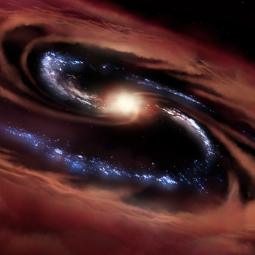By Kevin Cooke, Allison Kirkpatrick, and Joan Schmelz
Paper:
Dying of the Light: An X-Ray Fading Cold Quasar at z ~ 0.405
Cooke, K. C. et al., 2020 ApJ 903 106
Galaxies evolve over cosmic time from brilliant blue star producers to dull red stellar graveyards – from the proverbial Blue-and-New to Red-and-Dead . Astronomers observe that the early universe is filled with galaxies with an average star formation rate hundreds of times that of today, but the population over time has become more dominated by galaxies where stars are no longer born. To understand how galaxies came to be, we must investigate how their star formation histories are affected by both stellar and non-stellar processes.
Star formation can be shut down through many routes, one of which relies on the supermassive black hole in the heart of massive galaxies. When a supermassive black hole actively accretes interstellar gas, the surrounding material becomes luminous across the electromagnetic spectrum. The energetic output from the resulting quasar has a tremendous effect on the host galaxy, heating and expelling the gas, and shutting down star formation. This feedback model is commonly cited as the method that causes a star-forming, gas-rich galaxy to transition to a non-star-forming, gas-poor galaxy. This crucial transition process is difficult to investigate, as the hot material surrounding the black hole outshines the host galaxy at nearly all wavelengths of interest. The one exception is the far infrared.
The HAWC+ instrument on SOFIA observes in this vital wavelength band. It is able to detect light from the star formation process without being overwhelmed by emission from the accreting black hole. The gas surrounding young stars is heated and reradiates its thermal energy in the far infrared. These observations are used to estimate the amount of star formation that has taken place over the past 100 million years.
SOFIA targeted a special cold quasar , a galaxy caught in that astronomically brief transition phase when the supermassive black hole is actively accreting but a significant amount of the infrared-luminous gas remains. Cold quasars continue to host star formation rates of ~100s of solar masses per year, hundreds of times more active than our own Milky Way Galaxy.
HAWC+ observations at 89 μm of the cold quasar, CQ4479, were combined with optical observations from the Sloan Digital Sky Survey, infrared data from the Spitzer and Herschel space telescopes, and X-ray data from XMM-Newton to model the stellar component of the galaxy and the accretion behavior of the black hole.
The optical to far-infrared data were fit with a collection of stellar population, dust, and black hole models to determine the relative contribution of each to the total amount of light emitted by the galaxy. This process accounts for energy balance between the stars and dust, ensuring that the re-processed light observed in the far-infrared is consistent with the amount of energy absorbed by the gas. CQ4479 is best fit with a star-formation rate of 95 solar masses per year, nearly 50 times the rate in the Milky Way. Results indicated that the inclusion of just one extra data point from SOFIA, which traces the peak of far-infrared emission, can better constrain the star formation estimate by nearly a factor of two.
The black hole growth rate is constrained using archival X-ray and [O III] optical emission data from the XMM-Newton and the Sloan Digital Sky Survey, respectively. The X-ray emission indicates a slower growth rate than the [O III] estimate. One possible explanation for this discrepancy is that the X-rays trace the accretion rate on more instantaneous time scales than the [O III], so the black hole could have slowed down its accretion, at least at the epoch of observation.
Overall, the results indicate that the stellar population and black hole mass in CQ4479 are growing at the same rate, which is surprising since theory predicts that black hole growth succeeds stellar growth. CQ4479 is at the lower mass end of both stellar mass and black hole mass. The active black hole and stellar population could continue to grow for another 500 million years, tripling the mass of each before the black hole halts star birth.
Cold quasars represent an early stage of active galactic nucleus feedback and are a valuable laboratory for understanding how star formation and active supermassive black holes can co-exist. This brief window, where the galaxy has not yet succumbed to the devastating effects of the quasar, can help explain how massive galaxies formed in the early universe. As the only telescope capable of observing the majority of the host galaxy's emission, observations from SOFIA are crucial for understanding how these galaxies evolved over cosmic time into the universe we see today.
